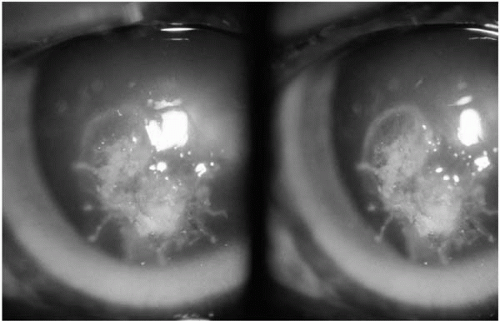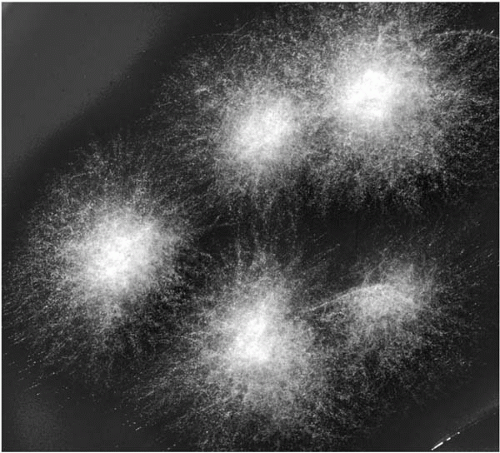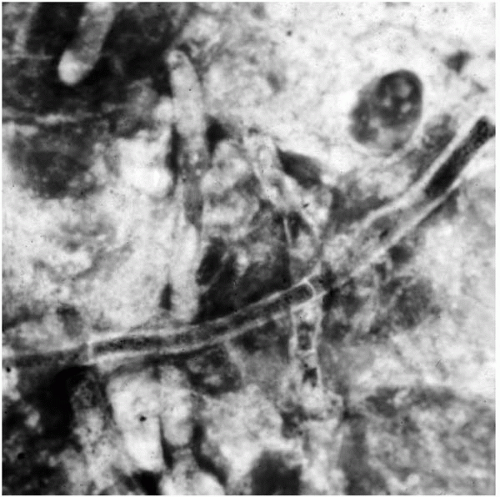Fungal Infections
Eduardo C. Alfonso
Richard K. Forster
Prashant Garg
Savitri Sharma
FUNGAL KERATITIS
Fungal keratitis is one of the most challenging types of microbial keratitis for the ophthalmologist to diagnose and treat. There has been an increase in the awareness and recognition of the clinical signs of fungal keratitis, particularly in geographic areas where these infections tend to be more commonly seen (e.g., rural areas and areas of warm climates). This has led to better and more frequent diagnosis and to improved management. Fungal keratitis remains a therapeutic challenge because its management is restricted by the paucity of effective antifungal agents and by the extent to which they can penetrate into corneal tissue. It is important, therefore, to understand the clinical picture presented by mycotic keratitis, and, as an aid in interpreting culture results, to know the fungi that most commonly cause it. Above all, it is important to have a rational and informed approach to the use of both diagnostic laboratory techniques and antifungal compounds and therapeutic alternatives. Here we review the current status of mycotic keratitis.
Incidence
The incidence of fungal keratitis is low (6% to 20%) when compared to bacterial keratitis in various series of microbial corneal ulcers, with more numerous reports of fungal keratitis from the southern United States (1, 2, 3). It continues to be a disease most commonly encountered in patients who come from a rural setting. Aspergillus sp. may be the most common organism responsible for fungal keratitis worldwide (4). Candida sp. and Aspergillus sp. are most frequently isolated in fungal keratitis in the northern United States, whereas Fusarium sp. predominates in the southern United States (5, 6, 7). Fusarium solani was the most commonly isolated organism in two series of fungal keratitis from South Florida (1,8). In a more recent study Fusarium oxysporum was the most common species (37%), followed by Fusarium solani (24%) (9). Candida sp., Curvularia sp., and Aspergillus sp. were the next most common fungal isolates in order of decreasing frequency. Fusarium sp. has been reported as an isolate in fungal keratitis in many regions of the world. The largest series of fungal keratitis are reported from India, with the most common fungal isolates being Aspergillus sp. (27% to 64%), followed by Fusarium sp. (6% to 32%), Penicillium sp. (2% to 29%), and a number of other rare organisms (10, 11, 12). Increased awareness of the occurrence and frequency of fungal keratitis, better recognition of the clinical features of these infections, and improved laboratory diagnostic techniques of direct examination of stained smears and culture of the causative fungi have all led to an increase in the frequency of correct diagnosis. The growing population in southern climates has probably also contributed to greater interest in diagnosing mycotic infections (13). Numerous case reports of less usual organisms have been reported as a cause of keratomycosis. Proper identification is important for future exposure prevention and for determining the best treatment modalities (14, 15, 16, 17, 18, 19, 20).
Etiology
Although there have been many different fungi associated with corneal infections, certain genera and species seem to predominate. Infections caused by the same or related species may present a generally similar picture and respond similarly to antifungal agents in vitro and clinically. Fungi gain access into the corneal stroma through a defect in the epithelial barrier. This defect is most often due to external trauma, including contact lenses, a compromised ocular surface, or previous surgery. Once in the stroma, fungi multiply and can cause tissue necrosis and a host inflammatory reaction. They can even penetrate deep into the stroma and through an intact Descemet’s membrane. It is thought that once fungi gain access into the anterior chamber or to the iris and lens, eradication of the organism becomes extremely difficult. Likewise, organisms that extend from the cornea into the sclera become difficult to control. Blood-borne growth inhibiting factors may not reach the avascular tissues of the eye, such as the cornea, anterior chamber, and sclera, which may explain why fungi continue
to grow and persist in these areas despite treatment. It also may be the reason why a conjunctival flap sometimes can help limit fungal growth (i.e., by bringing to avascular tissue blood-borne growth-inhibiting factors (21).
to grow and persist in these areas despite treatment. It also may be the reason why a conjunctival flap sometimes can help limit fungal growth (i.e., by bringing to avascular tissue blood-borne growth-inhibiting factors (21).
TABLE 16-1. FUNGAL ISOLATES FROM KERATITIS, BASCOM PALMER EYE INSTITUTE, MIAMI. 1982-2003 | ||||||||||||||||||||||||||||||||||||||||||||||||||||||||||||||||||||||||||||||||||
|---|---|---|---|---|---|---|---|---|---|---|---|---|---|---|---|---|---|---|---|---|---|---|---|---|---|---|---|---|---|---|---|---|---|---|---|---|---|---|---|---|---|---|---|---|---|---|---|---|---|---|---|---|---|---|---|---|---|---|---|---|---|---|---|---|---|---|---|---|---|---|---|---|---|---|---|---|---|---|---|---|---|---|
|
Over the last several years we have been able to recognize and catalog certain fungi as frequent or repeated causes of mycotic keratitis. In Miami, Fusarium sp. are the most commonly isolated filamentousous fungi and Candida sp. the most common yeast (Table 16-1). A list of the more frequent causes of fungal keratitis include, in addition to Fusarium sp., Aspergillus fumigatus and Aspergillus flavus, Paecilomyces lilacinus, and Petriellidium boydii; the pigmented fungi (22), species of Curvularia, Drechslera, Alternaria, and Phialophora; as well as tropical fungi such as Lasiodiplodia and Colletotrichum, which are associated with lesions in plants. Any of these species isolated from corneal ulcerative stromal inflammation would be highly suspect as being the causative agent, as are other fungi when they are isolated from carefully made cultures (see Laboratory Diagnosis, below). Although Fusarium sp. may be especially common as a cause of keratitis in southern Florida, it is also by far the most common isolate in other parts of the United States, other Western Hemisphere nations, and in fact all parts of the world. Before 1974, nearly 50% of reported cases of keratomycosis were attributed to Aspergillus; nearly 25% to C. Albicans; and the remaining 25% to diverse fungi among which F. solani was increasingly commonly identified after 1970 (23). This change in isolated organisms prevalence probably resulted from improved mycologic identification rather than from a real change in prevalence. Most of the fungi causing keratitis are opportunistic organisms and are ubiquitous as plant pathogens or in the soil. How they become established in the corneal stroma after minor trauma, presumably involving implantation of the organism from some outdoor plant material, is not completely understood. But there are many cases in which the association between infection (after trauma or injury to the cornea) and plant material is well documented.
An early report of fungal ulcers from southern Florida showed an absence of keratitis during the hot, humid, rainy months of June to September (24). In recent years, however, fungal keratitis, most frequently caused by filamentous fungi other than F. solani and yeasts, has also been seen during the summer months. November and March, usually dry, cool, and windy months in southern Florida, remain the peak months for the occurrence of fungal keratitis (1). There is possibly an association of keratitis with dry, windy weather following a wet period suitable for fungus growth.
Zygomycetes (Phycomycetes) and dermatophytes (ringworm fungi) are rarely reported as causes of fungal keratitis. But many, or perhaps most, fungi may have the potential to cause keratitis, given the right combination of organism, trauma leading to implantation, and host factors. However, the most common causes are those most frequently encountered after apparently negligible trauma.
Clinical Features
Risk Factors
Trauma is the most frequent risk factor for the onset of fungal keratitis; it was the major risk factor in 44% of patients in a recent study (9). Trauma most often occurs outdoors and involves plant matter. Gardeners using motorized lawn mowers and trimmers are specially predisposed (9,25,26).
Fungal keratitis can also be associated with contact lens wear, and fungi have been recovered from contact lenses (27, 28, 29, 30, 31). The incidence of fungal keratitis in contact lens wearers has been reported as 4% for cosmetic (phakic and aphakic) contact lens wearers and in 27% in therapeutic lens users (32,33). Filamentous fungi are more commonly
associated with cosmetic lens wear, and yeasts with therapeutic lens use (34). In large series of contact lens-related microbial keratitis, few cases of fungal keratitis were associated with contact lens wear. The decreased number of fungal infections in contact lens wearers compared to noncontact lens wearers is statistically significant (35). Similar findings have been reported from India (36) and Singapore (37). It has been theorized that this difference could be due to a lower association between contact lens wear and other risk factors for fungal keratitis or a protective mechanism against fungal invasion into the cornea by the presence of the contact lens.
associated with cosmetic lens wear, and yeasts with therapeutic lens use (34). In large series of contact lens-related microbial keratitis, few cases of fungal keratitis were associated with contact lens wear. The decreased number of fungal infections in contact lens wearers compared to noncontact lens wearers is statistically significant (35). Similar findings have been reported from India (36) and Singapore (37). It has been theorized that this difference could be due to a lower association between contact lens wear and other risk factors for fungal keratitis or a protective mechanism against fungal invasion into the cornea by the presence of the contact lens.
The use of topical and systemic corticosteroids has been associated with the development of and worsening of fungal keratitis. Steroids impair the host immunologic response to the microbial invader (38,39). Topical anesthetic abuse has also been associated as a risk factor for Candida keratitis (40).
Patients with vernal or allergic conjunctivitis may also be predisposed to fungal keratitis (41). It has also been reported in atopic patients (42).
Corneal transplant and refractive surgery have also been associated with fungal keratitis (43,44). Predisposing factors for the development of fungal keratitis in patients after keratoplasty include loose sutures, chronic topical steroid use, chronic antibiotic use, contact lens wear, graft failure, and persistent epithelial defects (44, 45, 46). The contamination of donor corneas is of special concern because no antifungal is routinely used in the preparation of the donor globe or in the solution used to preserve the tissue before transplantation (47). Routine culture of donor rims and media may aid in the identification of the organism and prompt initiation of antifungal treatment (48).
Fungal keratitis has been reported to be associated with refractive surgery (43,53). It can occur in the immediate postoperative period or later. The early form may be associated with the direct surgical contamination of the cornea. The late form is usually associated with trauma (54). It was associated with contamination from a pet in one case report (55). Mild trauma allows the organisms to penetrate through the diseased epithelium directly into the stroma, avoiding Bowman’s layer (56,57). Delayed diagnosis may worsen the outcome of fungal keratitis after refractive surgery (58, 59, 60). It can also occur after enhancement procedures (61).
Systemic diseases associated with inmunosuppression may increase the risk for the development of fungal keratitis. One series reported a 12% incidence of diabetes mellitus in a group of patients with fungal keratitis; the incidence of diabetes mellitus in the United States is estimated to be only 1% of the population (9). Patients chronically ill and hospitalized in intensive care units also may be predisposed to the development of fungal keratitis, usually with Candida sp. In a series from Africa, HIV-positive patients were more likely to develop fungal keratitis compared to non-HIV patients (49). In patients with leprosy, fungal ulcers may be more common (50).
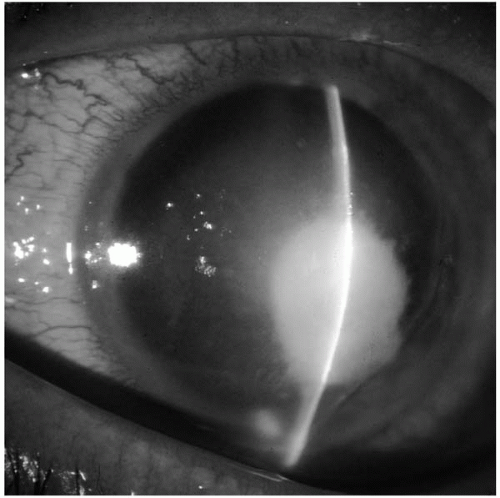 FIGURE 16-1. Slit lamp biomicroscopic view of fungal keratitis (Fusarium solani) with dry infiltrate elevated above the level of the corneal surface. |
Keratomycosis in children is usually associated with trauma with organic matter. In one series fungal keratitis comprised 18% of all cases of keratitis cultured in children (51). It may be difficult to establish a history of trauma with organic matter in pediatric patients, and so all children with keratitis should be cultured for fungi (52).
The salient features of fungal keratitis have been described, and although satellite lesions, presumed immune rings, and endothelial plaques may not be unique to fungal keratitis, these features and the following ones should elevate one’s suspicion of a fungal infection: stromal infiltrates with feathery, hyphate edges; and infiltrates that tend to be dry, gray, and somewhat elevated above the level of the corneal surface (Figs. 16-1 and 16-2) (62). Keratitis caused by yeasts may be more localized and have a “collar button” configuration, often with a small ulceration and an expanding although discrete stromal infiltrate (Fig. 16-3). But whether or not these suggestive slit-lamp features exist, any corneal stromal infiltrate with ulceration, or even with an intact epithelium, should be considered a microbial infection, and fungus can be the microbe (63). A complete microbiologic diagnostic workup, including harvesting of material for the isolation of bacteria, fungi, and Acanthamoeba, should be performed in all patients with such infiltrates (64). Unrecognized and undiagnosed fungal keratitis inadvertently treated with corticosteroids will worsen. Herpes keratitis may be the condition most commonly confused with keratomycosis (65).
Laboratory Diagnosis
After a careful clinical history is obtained and the clinical features of the stromal keratitis are documented, the next essential step is to promptly perform laboratory studies (68,69). Corneal scrapings are best obtained with a sharpened spatula or a surgical blade. This method is preferred to the use a calcium alginate, Dacron/rayon swab, or a sponge-type material. The organisms may be deep in the tissue and not accessible to swabbing. Scraping also provides for initial debridement of organisms and of epithelium, which may provide a barrier to antifungal drug penetration. A diamond-tipped motorized burr may also be useful to obtain the scrapings. When corneal scrapings are negative, a diagnostic superficial keratectomy or corneal biopsy may be performed. A 2- to 3-mm sterile disposable dermatologic trephine is advanced into the anterior corneal stroma to incorporate both infected and adjacent clear cornea. The visual axis should be avoided if possible. But we would emphasize that the primary goal must not be a compromised biopsy of the infiltrate, even if it is in the visual axis and even if it is deep. The base is then undermined with a surgical blade to complete the lamellar keratectomy (70,71). The corneal biopsy specimen should be submitted for smears, cultures, and histopathologic examination. In some cases of deep keratitis with an intact overlying epithelium and stroma, a 27-gauge hypodermic needle or a 6-0 silk suture can be introduced into the infiltrate to obtain a specimen for culture.
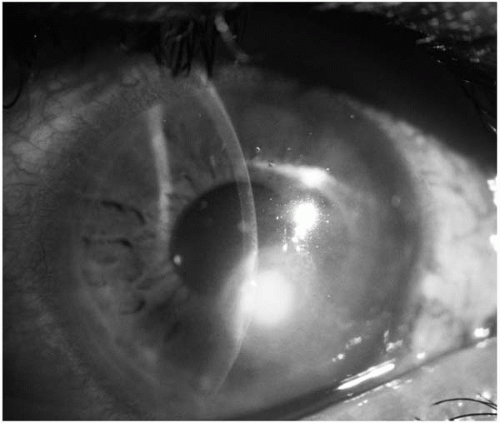 FIGURE 16-3. Stromal keratitis caused by mixed infection with Candida parapsilosis and Fusarium oxysporum. Note the more localized, discrete infiltrate underlying the small ulceration. |
A corneal biopsy has been shown to have better yield than scrapings for recovering fungi. In animal experiments, corneal scrapings found three of 10 specimens positive for C. albicans, five of 10 for F. solari, and six of 10 for A. fumigatus corneal biopsy specimens demonstrated fungal elements in all inoculated eyes (72). Furthermore, comparing the value of direct examination and culture of biopsy specimens, cultures found seven of 10 specimens positive for C. albicans, and eight of 10 for F. solani and A. fumigatus; direct examination demonstrated positive-positive fungal elements in all specimens (73). Alexandrakis et al. (70) also demonstrated an increased recovery rate of organisms from corneal biopsy specimens from recalcitrant, culture-negative cases. In initial cases of keratitis the corneal biopsy has also been shown to have an increased recovery rate of organisms (9). An anterior chamber tap can be performed to isolate fungal
organisms that may have penetrated through an intact Descemet’s membrane. Under aseptic conditions, the hypopyon and or endothelial plaque can be aspirated and submitted for laboratory examination (74).
organisms that may have penetrated through an intact Descemet’s membrane. Under aseptic conditions, the hypopyon and or endothelial plaque can be aspirated and submitted for laboratory examination (74).
We routinely inoculate two blood agar plates: one to be maintained at room temperature for fungus growth, and the other at body temperature (35-37°C) for bacterial growth. A Sabouraud agar plate containing gentamicin (50 μ/mL) but without cycloheximide (which inhibits saprophytic fungi) should also be inoculated and incubated at room temperature. A chocolate agar plate is incubated at 37°C in a candle jar. Thioglycolate broth is also routinely inoculated and incubated for possible anaerobic growth at 35° to 37°C. By convention, to indicate the site of inoculation on solid medium, harvested material is inoculated in the form of a “C” streak, with each row of “C” streaks on each medium being made from a separate scraping (Fig. 16-4). Therefore, it is apparent that in order to produce two or three rows of “C” streaks, 10 to 15 individual scrapings of the corneal inflammatory material are required. In addition to the cultures, scraped material is placed on three or four slides for Gram’s and Giemsa stains as well as on a gelatin- or albumin-coated slide to be used for Gomori methenamine-silver stain. If adequate corneal material is available, it is appropriate to smear an additional slide that can be held in reserve for special or repeat stains.
Review of laboratory results in cases of culture-proved keratitis indicates that Gram’s stains of corneal scrapings were positive for hyphal elements in 55% of the cases, and Giemsa stains in 66% (Fig. 16-5) (1). A shortened technique for the preparation of the Gomori methenaminesilver stain for fungi has proved highly reliable in confirming the diagnosis of fungal keratitis from scrapings (Fig. 16-6) (75). The stain can also be used for restaining Gram- and Giemsa-stained slides and will often reveal hyphae not clearly shown by the other staining procedures. In a series of 133 culture-proved cases of fungal keratitis Gram’s and Giemsa stains were performed in 94 cases (1). Fungal hyphae were present on two or more slides in 60% of these and on only one slide in 21%. No hyphae were seen in 19%. Other methods of examining smears in patients with suspected fungal keratitis are potassium hydroxide (10% to 20%) wet preps (76), acridine orange staining, Grocott’s methenamine silver technique (77), lectins (78), and calcofluor white preparations (69,75,79, 80, 81).
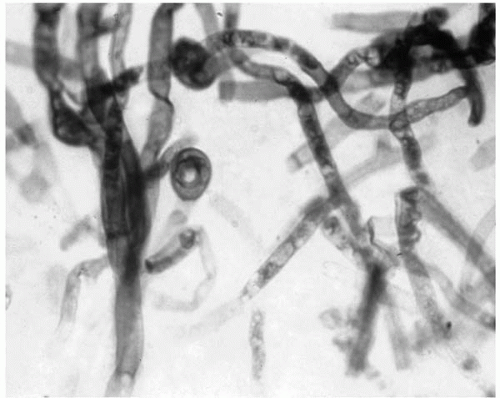 FIGURE 16-6. Gomori’s methenamine-silver stain of corneal scraping. Note the staining of cell walls and septa. |
Although Sabouraud agar with gentamicin and without cycloheximide incubated at room temperature is still the most sensitive medium for isolating fungi, sheep or rabbit blood agar incubated at room temperature is nearly as successful. Blood agar at 37°C was positive for fungi in about 35% of the cases, and liquid brain-heart infusion (BHI) medium maintained on a rotary shaker at room temperature was positive for fungi in about 50% of cases. Fungal isolates were detected on one or more media in 84 of 105 consecutive cases and on only one medium in 21 cases. In each instance of growth limited to a single medium, the presence of fungus was confirmed by microscopic examination of the scraping. Increasing the humidity of the medium by placing the inoculated agar plates in plastic bags has also been recommended for enhancement of fungal growth (82).
Almost all ocular fungal isolates grow and become evident in 48 to 72 hours. Most, in fact, are visible with the dissecting microscope or naked eye within less than 36 hours. But one should wait a week before declaring a culture negative for fungi. One report indicated slower growth of fungi from eye cultures and a lower incidence of detection by solid media or stained scrapings (83). However, this is in sharp contrast to the results obtained in a series of 134 isolations from 133 ocular fungus infections (1).
Newer methods for the identification of fungi, although still not widely available, include immunofluorescence staining, electron microscopy, and polymerase chain reaction (84, 85, 86, 87). Fungi have been recovered from topically applied medications, cosmetics, contact lenses, and their storage and cleaning solutions in patients with fungal keratitis. These items, therefore, should be obtained from the patient at the initial visit. Cultures and smears should be obtained to increase the chances of identifying the causative organism (88, 89, 90).
There is little evidence that topical antibiotics aggravate fungal keratitis. Likewise, fungi do not seem to alter or contribute to the normal ocular flora of the conjunctival surface and the cul-de-sac. (See the first section of this chapter for the culture characteristics of the fungi.)
Histopathology
The classic histopathologic findings in fungal keratitis include two features that are considered to be suggestive of progressive pathogenicity: fungal hyphal elements oriented perpendicular to the normal corneal lamellae, and a tendency for hyphal elements to penetrate intact Descemet’s membrane (91). We examined over 30 ocular specimens histopathologically (Fig. 16-7); some were whole eyes, but 29 were therapeutic penetrating keratoplasty specimens after medical treatment failures in which the infection had progressed to frank or impending perforation (92). We noted the presence of limbal infiltrates (Fig. 16-8) and a tendency toward progressive keratitis in cases of impending
perforation and abscess formation. We also recognized the following syndrome: After initial laboratory proof of fungal keratitis and treatment with topical antifungal agents, there was initial improvement, followed, after approximately 2 weeks of therapy, by progressive ulceration that necessitated penetrating keratoplasty or keratectomy with a conjunctival flap. In these cases, abnormal degenerated hyphal forms were seen histopathologically, sometimes associated with negative cultures obtained at the time of surgery (92,93). This finding suggests the need to evaluate factors that contribute to progressive keratitis even in the presence of antifungal treatment that leaves nonviable fungal elements in the corneal stroma. A localized inflammatory reaction at the limbus characterized by a collection of round cells and plasma cells was also observed in some of these histopathologic specimens. This suggests that immune mechanisms contribute in some instances to progressive ulceration.
perforation and abscess formation. We also recognized the following syndrome: After initial laboratory proof of fungal keratitis and treatment with topical antifungal agents, there was initial improvement, followed, after approximately 2 weeks of therapy, by progressive ulceration that necessitated penetrating keratoplasty or keratectomy with a conjunctival flap. In these cases, abnormal degenerated hyphal forms were seen histopathologically, sometimes associated with negative cultures obtained at the time of surgery (92,93). This finding suggests the need to evaluate factors that contribute to progressive keratitis even in the presence of antifungal treatment that leaves nonviable fungal elements in the corneal stroma. A localized inflammatory reaction at the limbus characterized by a collection of round cells and plasma cells was also observed in some of these histopathologic specimens. This suggests that immune mechanisms contribute in some instances to progressive ulceration.
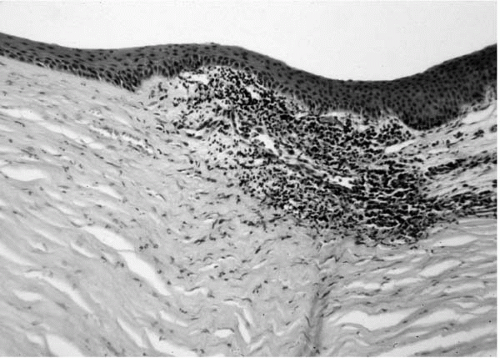 FIGURE 16-8. Limbal infiltrate with round cells and plasma cells associated with progressive stromal ulceration. |
Progressive keratitis in laboratory animals is difficult to establish without corticosteroids, and fungal keratitis has to date been reported infrequently in animals such as the dog and horse (see the first section of this chapter).
Antifungal Agents
Although less frequently encountered than bacterial keratitis, fungal infections of the cornea remain difficult to treat, and most ophthalmologists are understandably uncertain in managing cases of presumed or culture-positive fungal keratitis.
The major problems in management are (a) choice of antifungal agents, (b) management of deep keratitis, and (c) delivery of antifungal therapy. The major limiting factors to successful management include (a) the sensitivity of the fungal infection to antimicrobial therapy, (b) the penetration of the antifungal agents into and through the cornea, (c) bioavailability and delivery of the drug, and (d) toxicity of the antifungal agents.
In the case of bacterial keratitis, the available agents penetrate the cornea well, there is a choice of nontoxic available agents, sensitivity patterns are reproducible and rapid, and there is a high correlation between in vitro and in vivo effects. In contrast, antifungal agents in general are of low solubility and penetrate nonlipid layers poorly, they tend to be toxic at adequate therapeutic concentrations, and there is marked and noticeable variability between the in vitro sensitivity patterns compared to in vivo efficacy. The pharmacokinetics, the effect of the immune response, and other unknown drug-microbe interactions are not well understood.
The major groups of antifungal agents are the polyenes, including amphotericin B, natamycin, and nystatin; the azoles, including clotrimazole, miconazole, ketoconazole, and fluconazole; and flucytosine. Before 1969, most cases of fungal keratitis were treated with topical amphotericin B (24). Successful treatment was variable and toxicity was (is) a problem. Subsequently, during the 1970s, the related polyene antifungal agent natamycin was used investigationally and became another treatment choice (94). In 1979 the Food and Drug Administration approved natamycin (Natacyn) for topical ocular use and Alcon Laboratories (Ft. Worth, Texas) made a 5% suspension commercially available on a case-by-case basis. Failure of infections to heal when treated with natamycin has been due to microbial resistance, to poor tissue penetration, and to as yet unidentified factors contributing to progressive keratitis (94,95).
O’Day and associates (96), in a series of experiments using an animal model of Candida keratitis, compared polyenes (amphotericin B and natamycin) with azoles, (miconazole and ketozonazole), and new triazole agents (fluconazole and saperconazole). They reported that amphotericin penetrated the cornea better than the polyene natamycin, and that the imidazoles penetrated poorly. In contrast, in a comparative study of corneal penetration of topical amphotericin B and natamycin, O’Day and associates (97) in 1986 reported the corneal uptake and penetration of C-labeled 0.15% amphotericin B and 5% natamycin in rabbits. Corneal levels of natamycin were substantially higher than those of amphotericin B. In corneas debrided of epithelium, both entered the stroma and aqueous, whereas in corneas with intact epithelium natamycin entered in greater amounts than amphotericin B. Further investigation of the influence of the corneal epithelium on the efficacy of topical antifungal agents reported by O’Day and associates (98) in 1984, employing a model of deep stromal C. albicans infection in rabbits, and comparing the efficacy of six topical antifungal agents in the presence of intact and debrided epithelium. In corneas debrided daily, the polyenes (amphotericin B and natamycin) exhibited significant antifungal effect. Removal of the epithelium adversely affected the efficacy of flucytosine; the imidazoles were not efficacious in this model. However, in 1992 O’Day and coworkers (99) demonstrated that the triazole saperconazole was effective in the management of Aspergillus species and C. albicans infections, and penetrates the cornea when applied topically to potential therapeutic levels. These animal penetration and efficacy studies suggest that the epithelium is an important barrier to penetration.
With the exception of penicillin, the mechanism of action of few antibiotics has been studied as extensively as that of the antifungal polyenes. These agents exert their effect by binding to sterols present in the cell membrane (100). They have no effect on cell membranes in which sterols are absent. They also have a greater affinity for ergosterol present in the fungus membrane, than for cholesterol in the animal membrane. This probably accounts for their in vivo selective antifungal effect in the treatment of mycotic disease in animals. However, their affinity for cholesterol is considerable, which makes them relatively toxic. Of the three principal polyene antimycotics used in medicine, amphotericin B, nystatin, and natamycin, only amphotericin B can be administered systemically, although its use and effectiveness are compromised by its toxicity. Functionally, the polyene antibiotics are divided into two
classes: large polyenes such as amphotericin B, and smaller polyenes such as natamycin. Although both bind to sterols, they differ in their subsequent effect on the cell membranes as a consequence of their relative size. The larger polyenes approximate the length of the cell membrane phospholipid and form narrow circular channels for the passage of potassium chloride and other ions. This free passage leads to electrolyte imbalance and subsequent death of the cell. However, the lethal effect of the large polyenes may be blocked or reversed by osmotic and electrolyte control of the surrounding medium. In contrast, the molecular length of the small polyenes such as natamycin, instead of forming channels, accumulate on the membrane, forming “blisters” that disrupt and cause the sterol phospholipid film to break down. This phenomenon is not reversible by osmotic or electrolyte control, and therefore the fungicidal end point of natamycin as observed in vitro tends to be more absolute. Whether or not these differences between the small and large
polyenes is of clinical importance is unknown, and in general the polyene antibiotics can be relied on to be effective in vitro against almost all fungi.
classes: large polyenes such as amphotericin B, and smaller polyenes such as natamycin. Although both bind to sterols, they differ in their subsequent effect on the cell membranes as a consequence of their relative size. The larger polyenes approximate the length of the cell membrane phospholipid and form narrow circular channels for the passage of potassium chloride and other ions. This free passage leads to electrolyte imbalance and subsequent death of the cell. However, the lethal effect of the large polyenes may be blocked or reversed by osmotic and electrolyte control of the surrounding medium. In contrast, the molecular length of the small polyenes such as natamycin, instead of forming channels, accumulate on the membrane, forming “blisters” that disrupt and cause the sterol phospholipid film to break down. This phenomenon is not reversible by osmotic or electrolyte control, and therefore the fungicidal end point of natamycin as observed in vitro tends to be more absolute. Whether or not these differences between the small and large
polyenes is of clinical importance is unknown, and in general the polyene antibiotics can be relied on to be effective in vitro against almost all fungi.
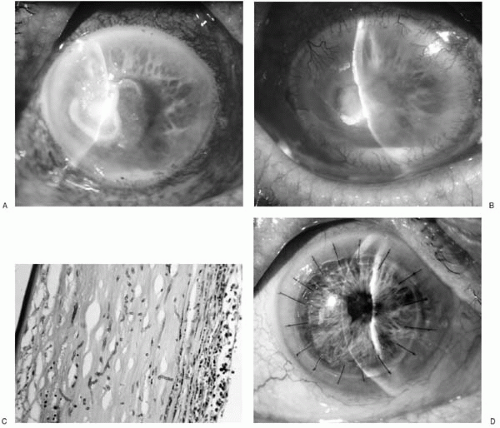 FIGURE 16-9. A: Indolent paracentral ulceration with necrotic borders initially seen 2 months after the onset of symptoms. Initial management was with bandage contact lens, topical corticosteroids, and antibiotics. Gram’s and Giemsa stains demonstrate hyphal elements. Curvularia senegalensis. B: Six weeks following natamycin therapy with progressive thinning and impending perforation. C: Histopathology from therapeutic penetrating keratoplasty. Note the superficial polymorphonuclear leukocyte response with hyphal elements throughout the depth of the cornea. D: Seven weeks postoperatively, preceding removal of interrupted sutures used in therapeutic keratoplasty.
Stay updated, free articles. Join our Telegram channel
Full access? Get Clinical Tree
 Get Clinical Tree app for offline access
Get Clinical Tree app for offline access

|
